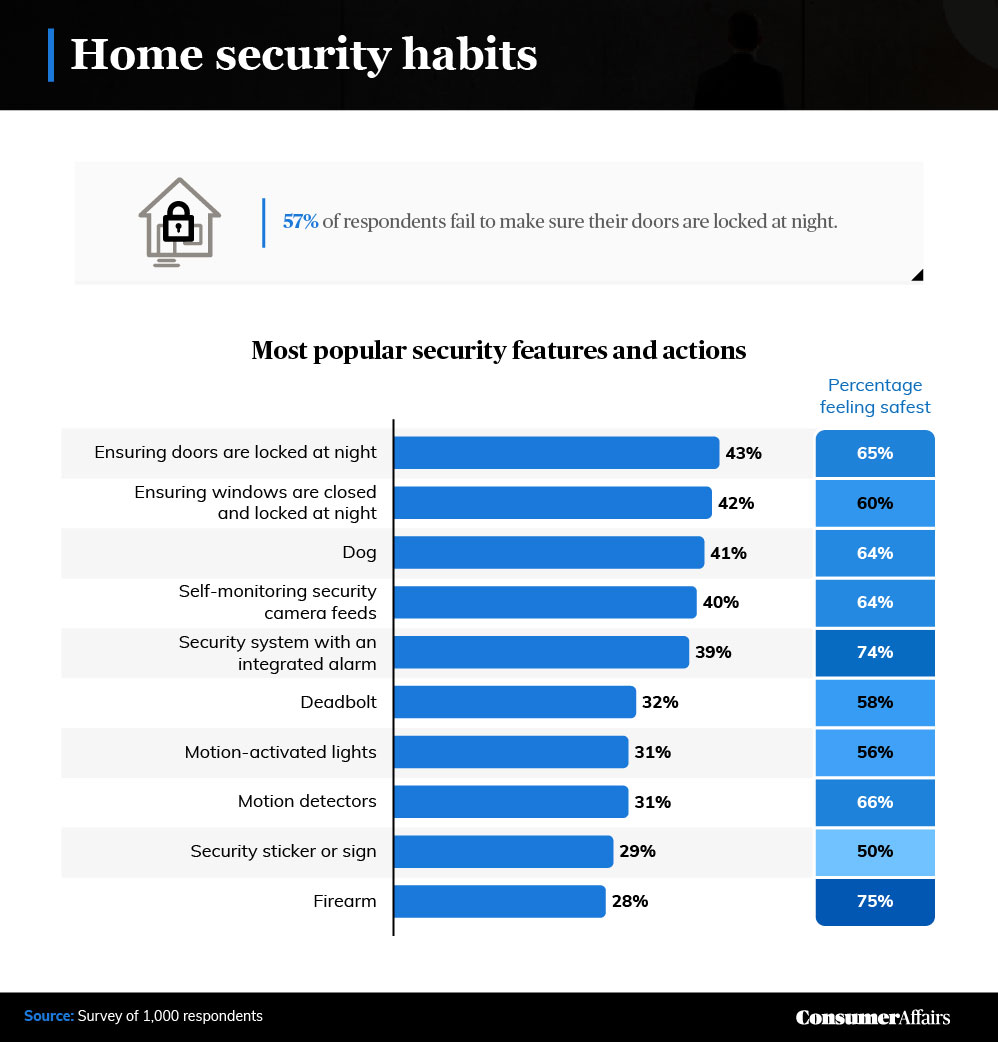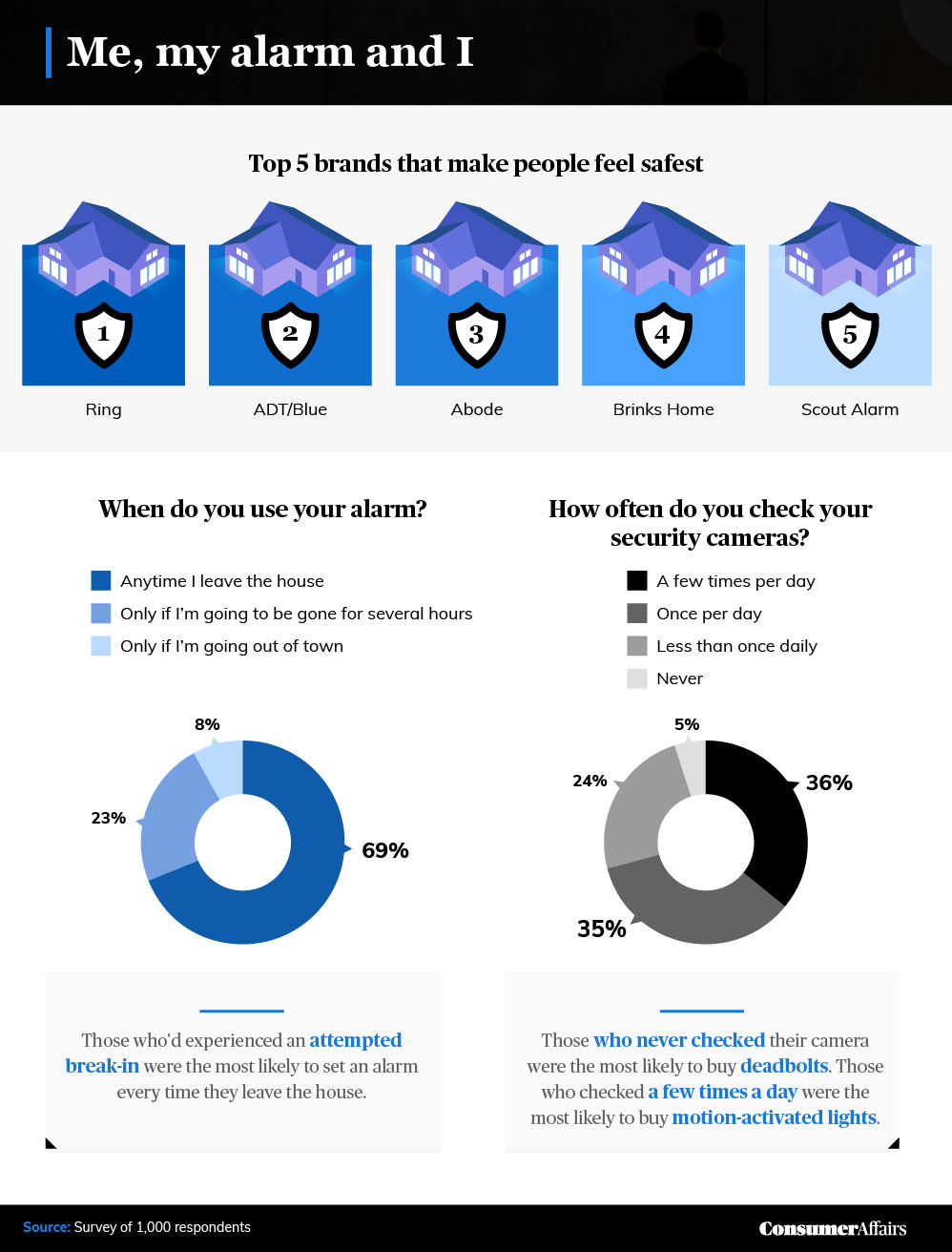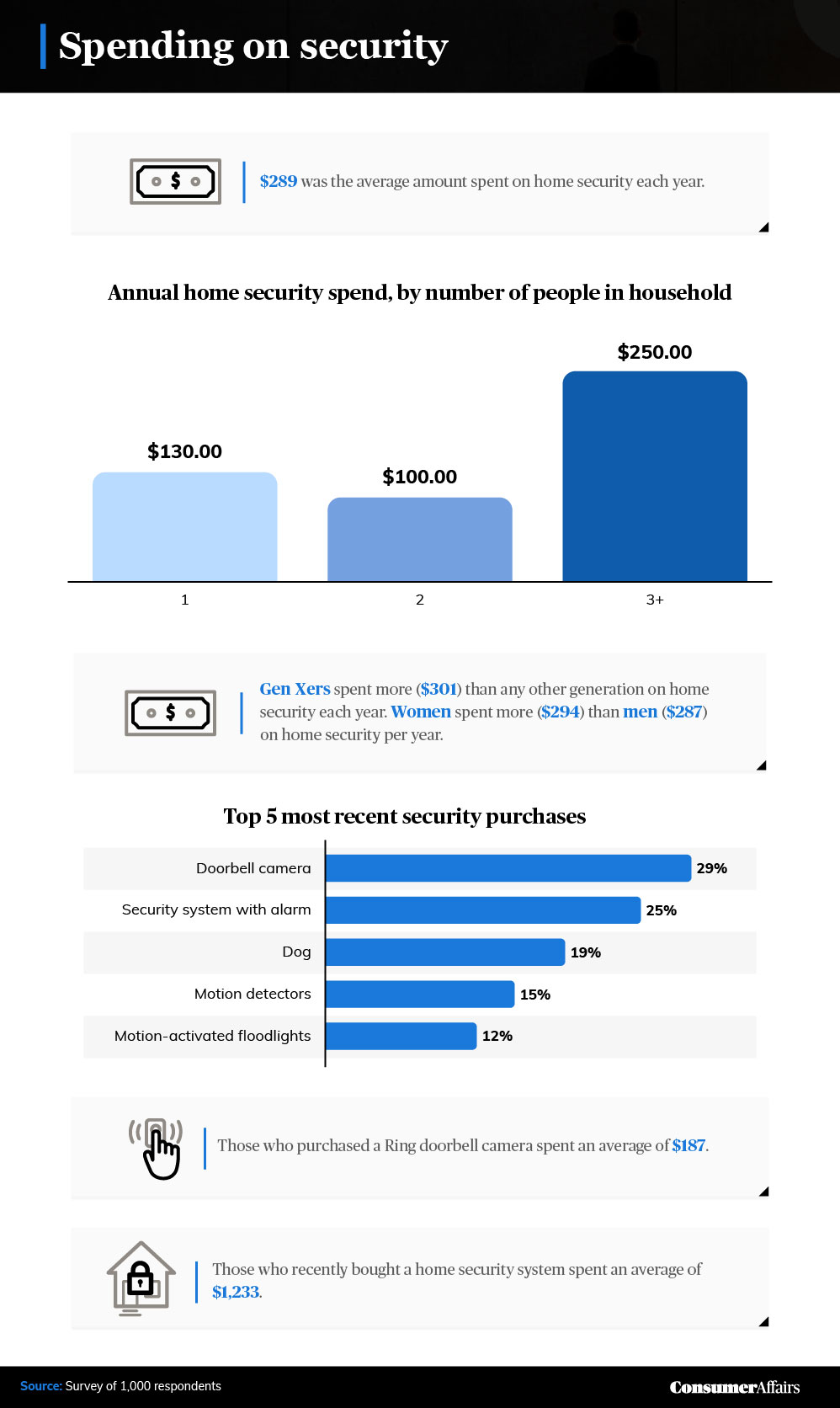Home security footage and changing habits

Key takeaways
- Fifty-seven percent of Americans reported failing to ensure their doors are locked at night.
- Americans who recently purchased a doorbell camera and/or improved home security said their greatest motivation for doing so was social media.
- Respondents spent an average of $289 per year on home security, with women spending more than men and families spending more than twice as much as couples.
- Viewing scary footage on Instagram caused people to spend more (about $331 per year) on home security expenses.
Home security fears in America
Attempted break-ins, package thefts, lurking strangers — these are just some of the crimes and suspicious behaviors caught on American doorbell cameras across the country. These videos are easily shareable, which has led to a noticeable trend on social media. Is regular exposure to online crime content affecting the average American? And, if so, how?
Join us as we explore the issues behind Americans’ home security fears and discover how our habits are changing in terms of keeping ourselves safe at home.
How secure are American homes?
Regularly securing your home can help prevent home invasion, property theft and physical harm. We took a look at the daily home security habits of our respondents to see what precautions they’re taking for home safety.

Firearms were the least popular security feature in American homes, with only 28% of respondents reporting owning one for safety.
We also discovered that firearms made men feel safer than women: 43% of men said firearms made them feel very safe — compared to 32% of women. Other studies have concluded that although there’s some evidence owning a firearm may reduce property loss, firearms don’t always make us safer. Home security systems, lights and locks — or a good old-fashioned baseball bat — might be equally advantageous alternatives.
The number of people who leave their door and window locks unchecked each night also might surprise you. The majority of respondents said they don’t ensure that their doors and windows are secured overnight, which could mean easy access for burglars. It’s important to note that thieves frequently enter homes through unsecured first-floor windows and open back doors.
One solution to this problem is to switch to smart locks. They provide keyless entry and can be programmed to lock automatically. Depending on which smart home security system you choose, you might also be able to control your locks from an app on your smartphone.
Top brands for home security
Many of today’s high-tech security products feature live and recorded video camera footage that you can check whether you’re home or away. Take a look at how often people review their security footage and which brands they most trust to keep their home safe.

Americans reported feeling safest in their homes with Ring security system products. The brand is known for its popular Ring doorbells, but it also offers home security cameras and smart lighting. Ring provides high-quality video surveillance, compatibility with Alexa-enabled devices and optional monitoring plans.
Among those who own security cameras, we found that more than 70% check their recordings once or more per day. Despite the fact that burglary rates are declining in the U.S., many continue to feel concerned about the safety of their homes.
How much Americans pay for safety
Prevention is the best way to protect yourself, your loved ones and your property. If you’ve been delaying home security measures due to cost, we have great news — they can actually be quite affordable. We found that there’s no need to spend thousands of dollars to feel safe in your home.

Our respondents spent an average of $289 per year on home security. That’s only around $24 a month, which for some is a small price to pay for increased safety and peace of mind.
For instance, the average spent on a Ring doorbell camera was $187. These are small investments that can be offset by other savings — you might even earn a discount on your home insurance premium after you install a smart security system.
The future of home security in America
Many Americans regularly check their own surveillance videos in addition to viewing other people’s recordings on social media. Though seeing suspicious behavior documented online has encouraged many people to change their home safety habits, others seem more unfazed.
We do know that the home security market is becoming increasingly tech-savvy. With internet-connected smart devices, you can control everything from lights to door locks through one centralized console or mobile app. As more people discover the benefits of smart home technology, integrated home security systems may become the new norm.
Methodology and limitations
We surveyed 1,000 respondents ranging in age from 18 to 75 years old in order to identify their home security habits, actions and motivations. The mean age was 42.
Fifty-four percent of respondents were men, 45% were women and 1% were nonbinary. Thirty-nine percent of respondents lived in urban areas, 40% lived in the suburbs, 9% lived in small towns and 12% lived in rural areas.
For short, open-ended questions, outliers were removed. To help ensure that all respondents took our survey seriously, they were required to identify and correctly answer an attention-check question.
Survey data have certain limitations related to self-reporting. These limitations include telescoping, exaggeration and selective memory. We didn’t weight our data or statistically test our hypothesis. This was a purely exploratory project that examined how social media might influence the purchasing decisions of Americans when it comes to home security.
Fair use statement
Most of us can benefit from learning more about home security. Please feel free to share our findings with others for any noncommercial purpose — just remember to provide credit for our work by linking back to this article.
You’re signed up
We’ll start sending you the news you need delivered straight to you. We value your privacy. Unsubscribe easily.
Social media’s effects on home security habits
American home security habits are changing due to the influence of social media. Apparently frequent posts featuring crime content have led some people to feel like they aren’t as safe as they could be in their own homes.
Exposure to crime content on social media was the No. 1 reason people felt compelled to buy a home security system — that’s a good thing, because 75% of homeowners reported seeing suspicious behavior once they had their cameras. Cameras and security alarms can help deter vandalism and theft and could help authorities locate perpetrators.
While social media was the greatest motivator for those living in suburban and urban areas, it tied with high local crime rates as the top influence for those in rural areas. For people living in small towns, high local crime rates took the top spot.
There was also a divide between those trying to prevent break-ins and those who’d already experienced burglary or vandalism. Social media and high local crime rates primarily convinced people to invest in doorbell cameras, while victims of previous crimes were compelled to get a dog, display security signs or install motion detectors.